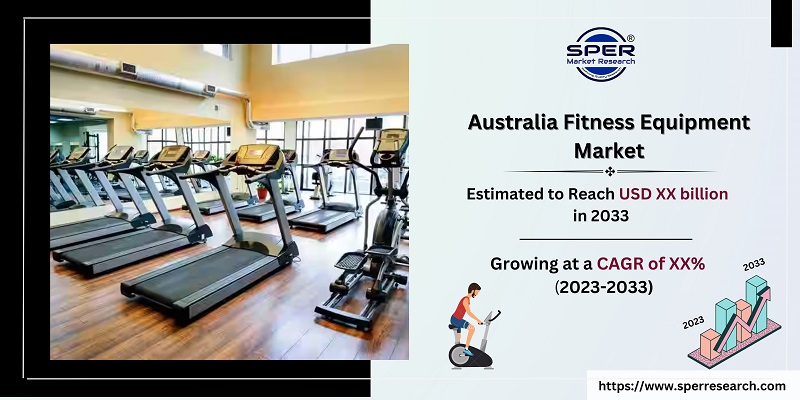
Australia Fitness Equipment Market Growth, Size, Trends, Scope, Revenue and Future Competition
Australia Fitness Equipment Market- By Type, By Cardiovascular Fitness Equipment, By Strength Fitness Equipment, By End User- Regional Outlook, Competitive Strategies, and Segment Forecast to 2033
| Published: May-2023 | Report ID: MACH2326 | Pages: 1 - 109 | Formats*: |
| Category : Equipment and Machinery | |||


| Report Metric | Details |
| Market size available for years | 2019-2033 |
| Base year considered | 2022 |
| Forecast period | 2023-2033 |
| Segments covered | By Type, By Cardiovascular Fitness Equipment, By Strength Fitness Equipment, By End-User. |
| Regions covered | New South Wales, Queensland, Tasmania, Victoria, Western Australia, Rest of Australia |
| Companies Covered | Technogym, Life Fitness, Matrix Fitness, Precor, Gymquip Fitness, Aussie Fitness Equipment. |
- Gyms and fitness centers
- Hotels and resorts
- Corporate wellness programs
- Rehabilitation centers
- Others
- Australia Fitness Equipment Market Value Share and Forecast, By Type, 2023-2033
- Cardiovascular
- Strength
- Australia Fitness Equipment Market Value Share and Forecast, By Cardiovascular Fitness Equipment, 2023-2033
- Treadmill
- Stationary bike
- Elliptical trainer
- Rowing machine
- Cross-Country ski
- Stair stepper
- Australia Fitness Equipment Market Value Share and Forecast, By Strength Fitness Equipment, 2023-2033
- Dumbbells
- Weight plates
- Hydraulic equipment
- Resistance bands & tubes
- Australia Fitness Equipment Market Value Share and Forecast, By End User, 2023-2033
- Commercial
- Residential
- New South Wales
- Queensland
- Tasmania
- Victoria
- Western Australia
- Rest of Australia
- Australia Fitness Equipment Market Size (FY’2023-FY’2033)
- Overview of the Australia Fitness Equipment Market
- Segmentation of the Australia Fitness Equipment Market By Type (Cardiovascular and Strength)
- Segmentation of the Australia Fitness Equipment Market By Cardiovascular Fitness Equipment (Treadmill, Stationary bike, Elliptical trainer, Rowing machine, Cross-country ski, and Stair stepper)
- Segmentation of the Australia Fitness Equipment Market By Strength Fitness Equipment (Dumbbells, Weight Plates, Hydraulic equipment, Resistance brands & tubes.
- Segmentation of Australia Fitness Equipment Market By End User (Commercial and Residential)
- Statistical Snap of the Australia Fitness Equipment Market
- Growth Analysis of the Australia Fitness Equipment Market
- Problems and Challenges in Australia Fitness Equipment Market
- Competitive Landscape in the Australia Fitness Equipment Market
- Impact of COVID-19 on Australia Fitness Equipment Market
- Details on Recent Investment in the Australia Fitness Equipment Market
- Competitive Analysis of Australia Fitness Equipment Market
- Key Players in the Australia Fitness Equipment Market
- SWOT Analysis of Australia Fitness Equipment Market
- Australia Fitness Equipment Market Future Outlook and Projections (FY’2023-FY’2033)
- Recommendations from Analyst
1.1. Scope of the report1.2. Market segment analysis
2.1. Research data source2.1.1. Secondary Data2.1.2. Primary Data2.1.3. SPER’s internal database2.1.4. Premium insight from KOLs2.2. Market size estimation2.2.1. Top-down and Bottom-up Approach2.3. Data triangulation
4.1. Driver, Restraint, Opportunity, and Challenges Analysis4.1.1. Drivers4.1.2. Restraints4.1.3. Opportunities4.1.4. Challenges4.2. COVID-19 Impacts on the Australia Fitness Equipment Market
5.1. SWOT Analysis5.1.1. Strengths5.1.2. Weaknesses5.1.3. Opportunities5.1.4. Threats5.2. PESTEL Analysis5.2.1. Political Landscape5.2.2. Economic Landscape5.2.3. Social Landscape5.2.4. Technological Landscape5.2.5. Environmental Landscape5.2.6. Legal Landscape5.3. PORTER’s Five Forces5.3.1. Bargaining power of suppliers5.3.2. Bargaining power of buyers5.3.3. Threat of Substitute5.3.4. Threat of new entrant5.3.5. Competitive rivalry5.4. Heat Map Analysis
6.1. Australia Fitness Equipment Market Manufacturing Base Distribution, Sales Area, Product Type6.2. Mergers & Acquisitions, Partnerships, Product Launch, and Collaboration in Australia Fitness Equipment Market
7.1. Australia Fitness Equipment Market Value Share and Forecast, By Type, 2023-20337.2. Cardiovascular7.3. Strength
8.1. Australia Fitness Equipment Market Value Share and Forecast, By Cardiovascular Fitness Equipment, 2023-20338.2. Treadmill8.3. Stationary bike8.4. Elliptical trainer8.5. Rowing machine8.6. Cross-Country ski8.7. Stair stepper
9.1. Australia Fitness Equipment Market Value Share and Forecast, By Strength Fitness Equipment, 2023-20339.2. Dumbbells9.3. Weight plates9.4. Hydraulic equipment9.5. Resistance bands & tubes
10.1. Australia Fitness Equipment Market Value Share and Forecast, By End User, 2023-203310.2. Commercial10.3. Residential
11.1. Australia Fitness Equipment Market Size and Market Share
12.1. Australia Fitness Equipment Market Size and Market Share By Type (2019-2026)12.2. Australia Fitness Equipment Market Size and Market Share By Type (2027-2033)
13.1. Australia Fitness Equipment Market Size and Market Share By Cardiovascular Fitness Equipment (2019-2026)13.2. Australia Fitness Equipment Market Size and Market Share By Cardiovascular Fitness Equipment (2027-2033)
14.1. Australia Fitness Equipment Market Size and Market Share By Strength Fitness Equipment (2019-2026)14.2. Australia Fitness Equipment Market Size and Market Share By Strength Fitness Equipment (2027-2033)
15.1. Australia Fitness Equipment Market Size and Market Share By End User (2019-2026)15.2. Australia Fitness Equipment Market Size and Market Share By End User (2027-2033)
16.1. Australia Fitness Equipment Market Size and Market Share By Region (2019-2026)16.2. Australia Fitness Equipment Market Size and Market Share By Region (2027-2033)16.3. New South Wales16.4. Queensland16.5. Tasmania16.6. Victoria16.7. Western Australia16.8. Rest of Australia
17.1. Technogym17.1.1. Company details17.1.2. Financial outlook17.1.3. Product summary17.1.4. Recent developments17.2. Life Fitness17.2.1. Company details17.2.2. Financial outlook17.2.3. Product summary17.2.4. Recent developments17.3. Matrix Fitness17.3.1. Company details17.3.2. Financial outlook17.3.3. Product summary17.3.4. Recent developments17.4. Precor17.4.1. Company details17.4.2. Financial outlook17.4.3. Product summary17.4.4. Recent developments17.5. Gymquip Fitness17.5.1. Company details17.5.2. Financial outlook17.5.3. Product summary17.5.4. Recent developments17.6. Aussie Fitness Equipment17.6.1. Company details17.6.2. Financial outlook17.6.3. Product summary17.6.4. Recent developments
SPER Market Research’s methodology uses great emphasis on primary research to ensure that the market intelligence insights are up to date, reliable and accurate. Primary interviews are done with players involved in each phase of a supply chain to analyze the market forecasting. The secondary research method is used to help you fully understand how the future markets and the spending patterns look likes.
The report is based on in-depth qualitative and quantitative analysis of the Product Market. The quantitative analysis involves the application of various projection and sampling techniques. The qualitative analysis involves primary interviews, surveys, and vendor briefings. The data gathered as a result of these processes are validated through experts opinion. Our research methodology entails an ideal mixture of primary and secondary initiatives.



Frequently Asked Questions About This Report
PLACE AN ORDER
Year End Discount
Sample Report
Pre-Purchase Inquiry
NEED CUSTOMIZATION?
Request CustomizationCALL OR EMAIL US
100% Secure Payment






Related Reports
Our Global Clients
Our data-driven insights have influenced the strategy of 200+ reputed companies across the globe.




















